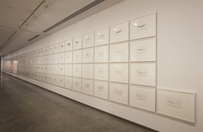Marco Fusinato
Melbourne
2017
Displayed 2017 at Museum of Contemporary Art Australia

Marco Fusinato
Born 1964, Melbourne. Lives and works Melbourne
Marco Fusinato is a contemporary artist and musician whose work has taken the form of installation, photographic reproduction, performance and recording. His overall aesthetic project combines allegorical appropriation with an interest in the intensity of a gesture or event. As a musician, Fusinato explores the notion of noise as music, using the electric guitar and associated electronics to improvise intricate, wide-ranging and physically affecting frequencies.
Artist text
by Blair French
Marco Fusinato’s Mass Black Implosion series began in 2007. Serial in form, each work uses an existing cultural document – a 20th or 21st-century avant-garde music score – as the formal, material and conceptual basis for a set of actions or interventions. Specifically, working with facsimile sheets of the score, Fusinato draws lines from each note on the page to one chosen point. Where a composition comprises more than one sheet, these are then singularly framed and installed sequentially on the gallery wall, creating an extraordinary graphic rendering of the energy of aural compression and expansion.
In these works, treated by Fusinato as propositions for new noise compositions, the qualities of each individual note and their relation to those around them are effectively compressed into a single point of intense concentration. This is the energy of implosion, which always infers at least the potential of its counter-energy in explosion, energy radiating out from the single point of origin. Fusinato’s intervention into the scores therefore visualises and proposes the possibility of a dialectical energy running through the original work that has a political dimension as much as an artistic one – a relentless propensity to both destruction and expressive creation in the single action, or in this case to the production of noise.
Fusinato has stated of these works:
The original scores are some of the best examples of applied musical thought, and my template equalises each one to a moment of singular impact. This idea of amplification/collapse is central to what I do. It’s a way of getting to the point in the most direct way. Everything becomes evident in the process. It’s a way of bringing everything down to its essence. (1)
For his template, Fusinato always chooses material by composers who attempt to change the language of music, including John Cage, Iannis Xenakis, Béla Bartók, Percy Grainger, Yves Klein, Glenn Gould, Jani Christou and Anestis Logothetis. Mass Black Implosion (Treatise, Cornelius Cardew) (2013) is, in scale, the most ambitious of these works to date, comprising 193 separately framed pages. The British composer Cornelius Cardew (1936–1981) wrote Treatise (1963–67) in the form of graphic notation. That is, he set out a visual language of lines, symbols and geometric forms without instructions about how the material should be played. Cardew’s intention was to allow free interpretation of his visual language, with no two performances sounding the same.
Similarly, Fusinato’s Mass Black Implosion works are both highly structured and formal, created almost laboriously with great care and attention to graphic detail, and accompanied by instructions to anarchic noise. In performance, all notes on the page would be played at once, transforming the scores from instructions to make sound through time into what he considers to be a statement of sound as an event. For example, while Fusinato’s treatment of Treatise leaves Cardew’s only reference to conventional musical notation – two five-line staves that run through each page – visible among the new network of lines, this conservation of a spacing of the composition through time is relentlessly counterpointed across the huge array of fine radiating ink rules by Fusinato’s consistent imploding of the work into singular noise.
Note
(1) Marco Fusinato, in ‘Amplifying your collapse: Marco Fusinato in conversation with Emily Cormack’, Artpulse, vol.4, no.16, 2013, http://artpulsemagazine.com/amplifying-your-collapse-marco-fusinato-in-conversation-with-emily-cormack.




